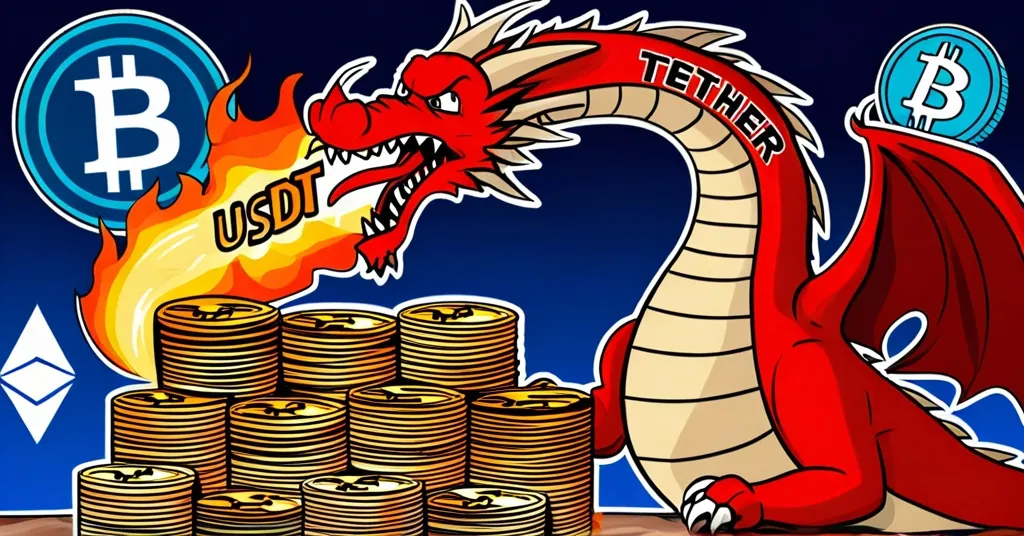Tether Burns 1B USDT: Impact on Bitcoin, Ethereum, and Crypto Market Dynamics

Tether’s Bold Move: Burning 1 Billion USDT and Its Ripple Effects on Bitcoin and the Crypto Market
What happens when a trillion-dollar company decides to burn $1 billion in a day? Tether, Inc. closed out 2024 with a bang by burning 1 billion USDT, reducing its total supply from 138 billion to 137 billion. This move, coinciding with a market dip that saw Bitcoin briefly fall below $93,000, has set off a chain reaction in the crypto world.
- Tether burns 1B USDT, reducing total supply
- Shift from TRON to Ethereum-based USDT
- Impact on Bitcoin and stablecoin dynamics
The Decision to Burn
Tether’s decision to burn 1 billion USDT at the end of 2024 was like a dramatic New Year’s fireworks display, but instead of lighting up the sky, it set the crypto market ablaze. The burn followed a year marked by aggressive liquidity injections and a peak supply of 140 billion USDT earlier in the year. But why burn 1 billion USDT? It’s a question that has many layers. The action may be a response to an anticipated decrease in USDT usage within the European Union, driven by the upcoming Markets in Crypto-Assets (MiCA) regulation. These new rules from the EU aim to control how cryptocurrencies like USDT can be used, imposing strict compliance requirements on stablecoins. Amidst the bull market of 2024, Tether raked in a hefty $2.55 billion in annual fees from USDT usage, making this burn a bold statement in managing supply amidst regulatory and market shifts.
Impact on TRON and Ethereum
Following this significant burn, the TRON network bore the brunt of the action, seeing its USDT supply shrink to 59.75 billion tokens. This aligns with Tether’s strategic pivot towards Ethereum-based USDT, reflecting broader market trends and potential regulatory pressures looming in the European Union. The total stablecoin supply also took a hit, dropping from 200.2 billion to 198.5 billion, with USDT facing the most significant reduction. This shift not only impacts liquidity but also fuels the growing DeFi ecosystem on Ethereum, as more USDT migrates to this platform. Ethereum’s advantages over TRON for USDT include its more extensive use in centralized trading and DeFi, making it a strategic move for Tether’s long-term plans.
Bitcoin and Market Dynamics
The implications for Bitcoin are particularly intriguing. The burn coincided with a market dip, suggesting a potential correlation between USDT liquidity and Bitcoin’s market dynamics. While Bitcoin remains the flagship cryptocurrency, its price movements are often tied to the broader liquidity environment, which stablecoins like USDT heavily influence. As Bitcoin maximalists would argue, Bitcoin’s resilience shines through even in these tumultuous times, potentially benefiting from a more controlled USDT supply.
Counterpoints and Criticisms
Tether’s move might look like a strategic masterstroke, but let’s not forget the elephant in the room: are they just trying to manipulate the market? Critics might argue that the burn could be a ploy to artificially boost the value of remaining USDT tokens. Additionally, the shift from TRON to Ethereum could disrupt users who have been relying on TRON-based USDT, creating friction and potential losses. As we champion decentralization and privacy, it’s crucial to question the motives behind such large-scale actions by centralized entities like Tether.
Key Questions and Takeaways
- What motivated Tether to burn 1 billion USDT at the end of 2024?
The burn was a strategic move to manage supply amidst market fluctuations and looming regulatory pressures, particularly with the EU’s MiCA regulation on the horizon.
- How has the USDT burn affected the overall stablecoin market?
The burn contributed to a reduction in the total stablecoin supply, primarily impacting USDT on the TRON network, which saw a significant decrease in its circulating supply.
- Why was the TRON network primarily affected by the USDT burn?
Tether is shifting its focus towards Ethereum-based USDT, which is more widely used in centralized trading and DeFi, leading to burns on the TRON network.
- What are the potential implications of this burn for Bitcoin?
The burn coincided with a market-wide dip, including a brief drop in Bitcoin’s price, suggesting a possible correlation between USDT liquidity and Bitcoin market dynamics.
- How might the upcoming EU regulations impact USDT usage?
The EU’s MiCA regulations may lead to decreased usage of non-compliant stablecoins like USDT, pushing users towards more compliant alternatives like USDC.
- What role do exchanges like Bitfinex and Binance play in this scenario?
These exchanges are actively involved in the redemption and potential shift away from TRON-based USDT, influencing market dynamics and liquidity shifts.
In the grand scheme, Tether’s move underscores the delicate balance between maintaining market liquidity and navigating regulatory landscapes. As we move forward, the crypto community will be keenly watching how these dynamics evolve, especially with the EU’s regulatory framework set to reshape the stablecoin market. For those new to the crypto world, “burning” refers to permanently removing tokens from circulation, often used to control supply and potentially increase value. “DeFi” stands for Decentralized Finance, a burgeoning sector where financial products are built on blockchain networks like Ethereum, often utilizing stablecoins like USDT for transactions.
As we navigate this thrilling saga, one thing remains clear: the crypto market is a beast of liquidity, regulation, and innovation, where every move can set off a chain reaction. Tether’s burn might just be the spark that ignites the next chapter in this evolving landscape.



